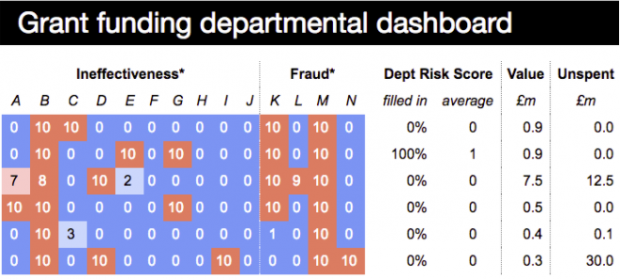The Better Use of Data (BUOD) team at GDS helps government departments apply data science techniques to policy and operational problems. Most technical work is done at GDS, but sometimes we embed people in teams across departments - including a project I did on grants efficiency at the Cabinet Office.
How this works
BUOD met with key members of the Cabinet Office Government Grants team to discuss the problem they were trying to solve and how data science could help. Working closely with experts from relevant departments is an important element of delivering successful data science projects (as explained in this post) and we agreed that embedding a data scientist in the Government Grants team would be the best way to fully understand the context of this work.
Government Grants
The Government awards £130 billion of grants each year. Much of this is calculated by a formula (for example, school grants), but around 20% is for ‘direct’ grants - projects which the government has more discretion about whether to fund.

The Cabinet Office Grants Efficiency Function looks across the whole of government to check that this large amount of public money is spent well. They make grants policy (e.g. financial and monitoring standards) and also review grants in partnership with departments. This project was about improving the way they use data to inform grant reviews and to identify potential fraud and inefficiency in the way grants are allocated.

What we achieved
A range of grant risk indicators had already been devised by internal and external risk and fraud experts. These are applied to the data gathered in the Government Grants Information System to highlight potential risk and efficiency savings. On joining the team I used these indicators to create an automatic assessment tool in Python. I also iterated them to increase their predictive accuracy (by creating a new indicator, making the variables in the model continuous rather than discrete, and performing variable selection using both a correlation matrix and expert knowledge about grants).
A key objective of the Grants team is to increase the insight departments can glean from the database, enabling them to make more informed decisions. To support this ambition I developed 2 dashboards in collaboration with Grant Champions (who are the central point for grants work in each department). One gives a general dynamic overview of grants in each department; the other displays grant risk indicators. Feedback from departments has been very positive and we are looking to further develop how we use management information to identify grant risk.
Next steps
We are just starting our ‘on the ground’ work reviewing grants with departments. This will give us access to new, richer data, in the form of text and case-working materials. The first phase of this project has successfully demonstrated how data science can be used to improve the grant making process; in fact there is so much potential in this area that I have been permanently assigned to the Cabinet Office grants team to continue this work.
If you're interested in working with GDS's Better Use of Data team please contact us at gdsdatascience@digital.cabinet-office.gov.uk.
